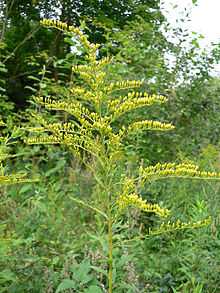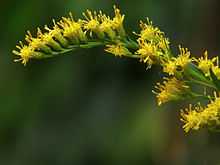Solidago canadensis
| Canada goldenrod | |
|---|---|
 | |
| Scientific classification | |
| Kingdom: | Plantae |
| (unranked): | Angiosperms |
| (unranked): | Eudicots |
| (unranked): | Asterids |
| Order: | Asterales |
| Family: | Asteraceae |
| Tribe: | Astereae |
| Genus: | Solidago |
| Species: | S. canadensis |
| Binomial name | |
| Solidago canadensis L. | |
| Synonyms[1] | |
| |
Solidago canadensis (known as Canada golden-rod or Canadian goldenrod) is an herbaceous perennial plant of the family Asteraceae native to northeastern North America but established as an invasive plant in many other regions.[2] It is often grown as an ornamental in flower gardens
The plant is erect, often forming colonies. Flowers are small yellow heads held above the foliage on a branching inflorescence.

Ecology and distribution
S. canadensis is sometimes browsed by deer and is good to fair as food for domestic livestock such as cattle or horses.[3]
It occurs throughout North America, in most US states and Canadian provinces.[3] It is found in a variety of habitats, although it is not shade tolerant. It typically is one of the first plants to colonize an area after disturbance (such as fire) and rarely persists once shrubs and trees become established. It is found neither in very dry locations nor in waterlogged ones.[3]
Invasive species
In many parts of Europe, Japan and China, it is established as an invasive weed.
In eastern and southeastern China, particularly the provinces of Zhejiang, Jiangsu, Jiangxi and Shanghai, its invasion has reached pandemic levels and has caused widespread concern. It has been reported that the invasion of the Canada Golden-rod along with other invasive plants, has caused the extinction of 30 native plants in Shanghai.[4]{dead link} In the city of Ningbo, Zhejiang, it has reduced local orange harvests.[5] It is still spreading across China, and sightings have been reported in as far as Yunnan province. Various national and provincial authorities have been on high alert.
In Fukushima it has taken over the rice fields that have been temporarily abandoned because of the nuclear power plant disaster.
References
- ↑ The Plant List, Solidago canadensis
- ↑ Flora of North America, Solidago canadensis, vol 20
- ↑ 3.0 3.1 3.2 "Fire Effects Information System: species reviews of fire and other ecology". 1993. Retrieved 2009-08-24.
|chapter=ignored (help) - ↑ Jiangsu's battle with Canada Goldenrod (Chinese)
- ↑ Jiaodianfangtan (Chinese)
External links
| Wikimedia Commons has media related to Solidago canadensis. |
- Jepson Manual Treatment: Solidago canadensis
- U.S. Geological Survey: Solidago canadensis
- Profile: Canada Goldenrod (Solidago canadensis) Photos, Drawings, Text. (Wild Plants of Winnipeg from Nature Manitoba)
- Exotic Plant Spreads Across a Third of Mainland
| Wikiversity has bloom time data for Solidago canadensis on the Bloom Clock |